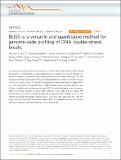BLISS is a versatile and quantitative method for genome-wide profiling of DNA double-strand breaks
Author(s)
Mirzazadeh, Reza; Garnerone, Silvano; Schneider, Martin W.; Kallas, Tomasz; Custodio, Joaquin; Wernersson, Erik; Bienko, Magda; Crosetto, Nicola; Yan, Winston Xia; Scott, David Arthur; Li, Yinqing; Gao, Linyi; Federova, Yana; Zetsche, Bernd; Zhang, Feng; ... Show more Show less
Downloadncomms15058.pdf (701.5Kb)
PUBLISHER_CC
Publisher with Creative Commons License
Creative Commons Attribution
Terms of use
Metadata
Show full item recordAbstract
Precisely measuring the location and frequency of DNA double-strand breaks (DSBs) along the genome is instrumental to understanding genomic fragility, but current methods are limited in versatility, sensitivity or practicality. Here we present Breaks Labeling In Situ and Sequencing (BLISS), featuring the following: (1) direct labelling of DSBs in fixed cells or tissue sections on a solid surface; (2) low-input requirement by linear amplification of tagged DSBs by in vitro transcription; (3) quantification of DSBs through unique molecular identifiers; and (4) easy scalability and multiplexing. We apply BLISS to profile endogenous and exogenous DSBs in low-input samples of cancer cells, embryonic stem cells and liver tissue. We demonstrate the sensitivity of BLISS by assessing the genome-wide off-target activity of two CRISPR-associated RNA-guided endonucleases, Cas9 and Cpf1, observing that Cpf1 has higher specificity than Cas9. Our results establish BLISS as a versatile, sensitive and efficient method for genome-wide DSB mapping in many applications.
Date issued
2017-05Department
Harvard University--MIT Division of Health Sciences and Technology; Massachusetts Institute of Technology. Department of Biological Engineering; Massachusetts Institute of Technology. Department of Brain and Cognitive Sciences; McGovern Institute for Brain Research at MITJournal
Nature Communications
Publisher
Nature Publishing Group
Citation
Yan, Winston X. et al. “BLISS Is a Versatile and Quantitative Method for Genome-Wide Profiling of DNA Double-Strand Breaks.” Nature Communications 8 (May 2017): 15058 © 2017 Macmillan Publishers Limited, part of Springer Nature
Version: Final published version
ISSN
2041-1723